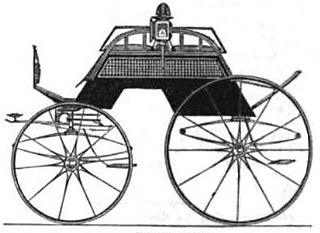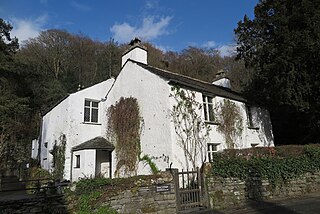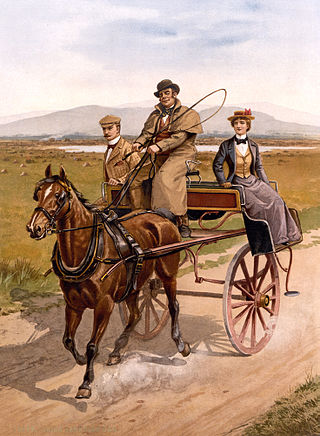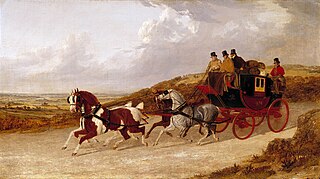
A cart or dray is a vehicle designed for transport, using two wheels and normally pulled by one or a pair of draught animals. A handcart is pulled or pushed by one or more people.

A coupe or coupé is a passenger car with a sloping or truncated rear roofline and two doors.

A carriage is a private four-wheeled vehicle for people and is most commonly horse-drawn. Second-hand private carriages were common public transport, the equivalent of modern cars used as taxis. Carriage suspensions are by leather strapping and, on those made in recent centuries, steel springs. Two-wheeled carriages are informal and usually owner-driven.

A hackney or hackney carriage is a carriage or car for hire. A hackney of a more expensive or high class was called a remise. A symbol of London and Britain, the black taxi is a common sight on the streets of the UK. The hackney carriages carry a roof sign TAXI that can be illuminated at night to indicate their availability for passengers.

Charles Bianconi was an Italo-Irish entrepreneur. Sometimes described as the "man who put Ireland on wheels", he developed a network of horse-drawn coaches that became Ireland's "first regular public transport" system. He eventually became known for his innovations in transport and was twice mayor of Clonmel, in County Tipperary.

William Percy French was an Irish songwriter, author, poet, entertainer and painter.

A coachman is an employee who drives a coach or carriage, a horse-drawn vehicle designed for the conveyance of passengers. A coachman has also been called a coachee, coachy,whip, or hackman.

A drive shaft, driveshaft, driving shaft, tailshaft, propeller shaft, or Cardan shaft is a component for transmitting mechanical power and torque and rotation, usually used to connect other components of a drivetrain that cannot be connected directly because of distance or the need to allow for relative movement between them.

The Toronto Street Railway (TSR) was the operator of a horse-drawn streetcar system from 1861 to 1891 in Toronto, Ontario, Canada. Its successor, the Toronto Railway Company, inherited the horsecar system and electrified it between 1892 and 1894.

A barouche is a large, open, four-wheeled carriage, both heavy and luxurious, drawn by two horses. It was fashionable throughout the 19th century. Its body provides seats for four passengers, two back-seat passengers vis-à-vis two behind the coachman's high box-seat. A leather roof can be raised to give back-seat passengers some protection from the weather.

A horse-drawn vehicle is a mechanized piece of equipment pulled by one horse or by a team of horses. These vehicles typically had two or four wheels and were used to carry passengers and/or a load. They were once common worldwide, but they have mostly been replaced by automobiles and other forms of self-propelled transport.

A dogcart is a light horse-drawn vehicle, originally designed for sporting shooters, with a box behind the driver's seat to contain one or more retriever dogs. The dog box could be converted to a second seat. Later variants included :

Dove Cottage is a house on the edge of Grasmere in the Lake District of England. It is best known as the home of the poet William Wordsworth and his sister Dorothy Wordsworth from December 1799 to May 1808, where they spent over eight years of "plain living, but high thinking". During this period, William wrote much of the poetry for which he is remembered today, including his "Ode: Intimations of Immortality", "Ode to Duty", "My Heart Leaps Up" and "I Wandered Lonely as a Cloud", together with parts of his autobiographical epic, The Prelude.

Recollections of a Tour Made in Scotland, A. D. 1803 (1874) is a travel memoir by Dorothy Wordsworth about a six-week, 663-mile journey through the Scottish Highlands from August–September 1803 with her brother William Wordsworth and mutual friend Samuel Taylor Coleridge. Some have called it "undoubtedly her masterpiece" and one of the best Scottish travel literature accounts during a period in the late 18th and early 19th centuries which saw hundreds of such examples. It is often compared as the Romantic counterpart to the better-known Enlightenment-era A Journey to the Western Islands of Scotland (1775) by Samuel Johnson written about 27 years earlier. Dorothy wrote Recollections for family and friends and never saw it published in her lifetime.

A mail coach is a stagecoach that is used to deliver mail. In Great Britain, Ireland, and Australia, they were built to a General Post Office-approved design operated by an independent contractor to carry long-distance mail for the Post Office. Mail was held in a box at the rear where the only Royal Mail employee, an armed guard, stood. Passengers were taken at a premium fare. There was seating for four passengers inside and more outside with the driver. The guard's seat could not be shared. This distribution system began in Britain in 1784. In Ireland the same service began in 1789, and in Australia it began in 1828.

A coach is a large, closed, four-wheeled, passenger-carrying vehicle or carriage usually drawn by two or more horses controlled by a coachman, a postilion, or both. A coach has doors in its sides and a front and a back seat inside. The driver has a raised seat in front of the carriage to allow better vision. It is often called a box, box seat, or coach box. There are many of types of coaches depending on the vehicle's purpose.

A brougham was originally a car body style where the driver sat outside and passengers seated within an enclosed cabin, as per the earlier brougham horse-drawn carriage. Similar in style to the later town car, the brougham style was used on chauffeur-driven petrol and electric cars.

A governess cart is a small two-wheeled horse-drawn cart. Their distinguishing feature is a small tub body, with two opposed inward-facing seats. They could seat four, although there was little room for four large adults. The driver sat sideways on one of these seats. The centre rear of the body was lowered, or else had a small hinged door, and there was a step beneath. The wheels were of moderate size, always fitted with mudguards, and usually carried on elliptical springs. The axle was either straight or dropped, giving a low, stable, centre of gravity.
The Irish Jaunting Car is a folk song associated with the United Kingdom and Ireland. The words were reportedly written by the entertainer Valentine Vousden in the late 1850s, shortly after Queen Victoria's visit to Ireland, and events of the Crimean War. The original words to the song are widely debated and disputed.

The Concord coach is a type of horse-drawn coach, often used as stagecoaches, mailcoaches, and hotel coaches. The term was first used for the coaches built by coach-builder J. Stephen Abbot and wheelwright Lewis Downing of the Abbot-Downing Company in Concord, New Hampshire, but later to be sometimes used generically. Like their predecessors, the Concords employed a style of suspension and construction particularly suited to North America's early 19th century roads. Leather thoroughbraces suspend passengers who are in constant motion while the coach is moving. The swaying is accepted by passengers for the shock absorbing action of the leather straps and for the way the special motion eases the coach over very rough patches of roadway. This suspension, which was developed by Philip de Chiese in the 17th century, was long replaced by steel springs in England.






















